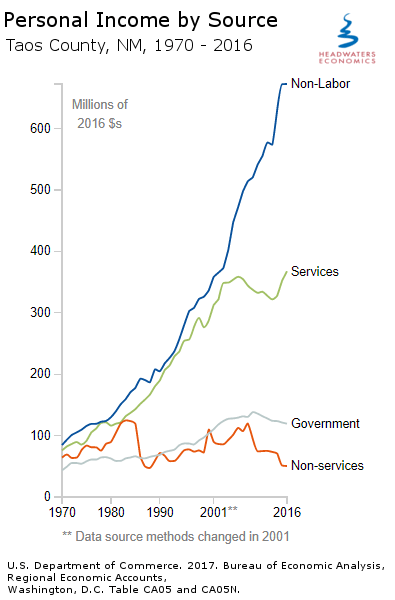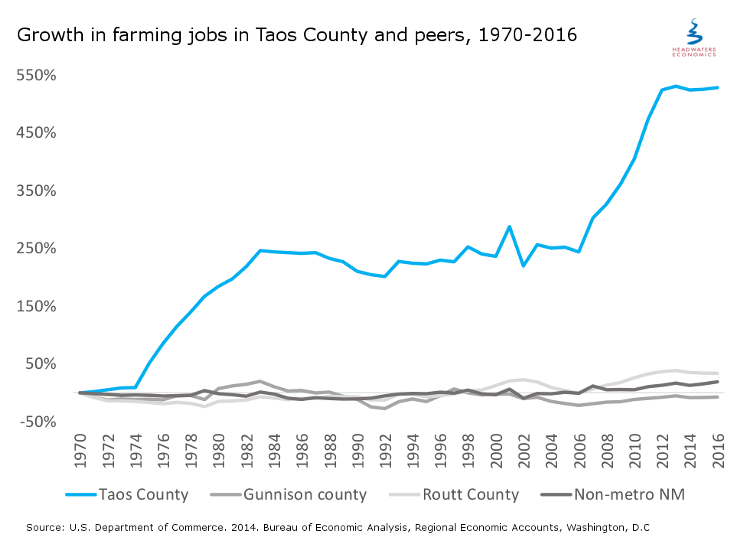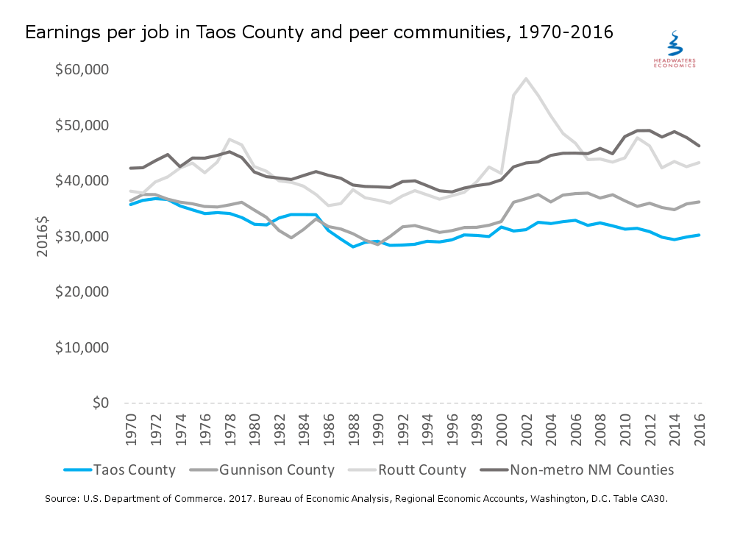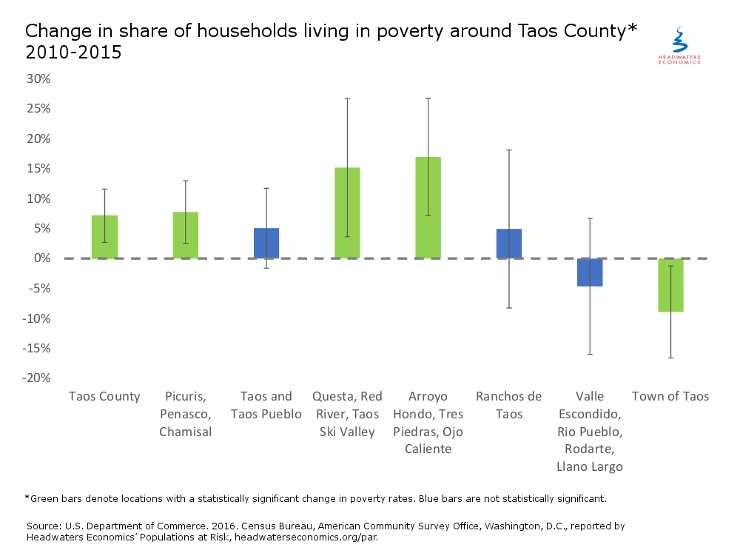- Long-term, steady growth in population and employment masks systemic socioeconomic challenges affecting many residents.
- In-migration of relatively wealthy households and a steady decline in earnings per job is leading to increasingly concentrated wealth and poverty around the county.
- Tourism-related jobs have made up a steady 40 percent of jobs in Taos County during the past two decades. Although less visible, jobs in small-scale agriculture have grown dramatically, pointing to additional economic potential.
As Taos has grown in popularity for retirees and outdoor enthusiasts, the community and economy have begun to change. The purpose of this report is to better understand some long-term trends in the economy and demographics of the community, to help inform economic development efforts underway, such as the Taos Strong at Heart process.
This report is intended to complement these ongoing efforts, to serve as a reference for residents who want to better understand the challenges and opportunities facing Taos County.
To provide context for understanding the Taos County economy, this report includes comparisons to three comparable peer communities: Gunnison County, Colorado (Gunnison and Crested Butte); Routt County, Colorado (Steamboat Springs); and non-metro (i.e., rural) New Mexico counties as a whole.
Economic Challenges and Opportunities in Taos County
In many ways, parts of Taos County look like other resort communities in the intermountain West: it has natural and cultural amenities that draw visitors from around the world who support a sustaining tourism economy with many residents employed in tourism-related industries. Taos’ popularity with visitors has led to an influx of retirees, numerous second homes, and rising cost of living. The county is becoming increasingly more expensive for renters in particular.
While Taos faces many challenges typical of an affluent resort community, at the same time it has chronic poverty and declining earnings per job, more characteristic of rural communities in New Mexico and beyond that do not have a strong tourism draw.
An influx of wealthy residents with investment income and retirees with pensions and 401k income means that nearly all new income in the county comes from non-labor sources, not from local jobs. Since 2000, 95 percent of income growth in the county is from non-labor income, with income from services, non-services, and government remaining flat or declining.
In addition to investment-related and aging-related non-labor income, hardship-related payments from Medicaid, welfare, and unemployment make up 13 percent of all income in the county. Hardship-related payments have increased substantially as a share of total income in the county (7% in 2000 to 13% in 2016), as have aging-related payments (9% in 2000 to 17% in 2016).
Taos County is unique among both rural and resort communities in the rapid growth of its agriculture sector, most of which has been in small-scale farming.
Unlike many of its resort peers, Taos has not yet been able to capitalize on its resort amenities, climate, and quality of life to attract high-paying jobs to the area. Although 2,086 new jobs were added in Taos County between 2000 and 2016, due to declining earnings per job these new jobs are not adding substantial new income. As a result, earnings per job has declined steadily over time.
Wealth and poverty are becoming increasingly concentrated in different parts of the county. Poverty is declining in downtown Taos, but rising elsewhere in the county.
Part of this concentration of wealth and poverty is due to an influx of new residents, who on average are wealthier than current residents and who are choosing to live near downtown Taos. The wealth coming into Taos through tourism and second home ownership is concentrated in areas like downtown Taos, making these areas less affordable for less affluent renters and homeowners.
Over time, concentrated wealth and poverty and growing inequality between these two groups will exacerbate existing problems of displacing a shrinking labor force and a lack of economic opportunity for all residents in the community.
Conclusion: Addressing the Economic Challenges and Opportunities in Taos County
Because Taos County has a cultural and economic diversity that many resort communities lack, it has retained a vibrancy and character that is eroded in many tourism-dependent towns. As many residents described during the Strong at Heart meetings, this unique culture draws long-time and new residents.
Taos County also has economic strengths beyond tourism: it has sustained steady growth without the boom-bust cycle of many tourism-dependent places, it has widespread and vibrant small-scale agriculture, and high wage services are present but could be developed more.
Maintaining this unique culture will require residents to find opportunities to integrate affordable housing and other land use planning strategies into increasingly popular areas to avoid creating islands of wealth and poverty and to keep less affluent residents at the center of Taos cultural and economic hubs.
While Taos County’s economy is performing reasonably well in terms of job creation, several areas currently are under-utilized. The tourism economy—a long-time backbone—has not been able to market the area as a good place for entrepreneurs and business owners. Identifying local success stories of entrepreneurs who moved their business to Taos could help turn tourists into committed residents.
The booming agricultural sector shows a widespread pursuit of small-scale farming. Building on the area’s existing reputation for unique, high-quality food, agriculture has the potential to provide an economic boost for many households and create a way to connect new and current residents, and potentially Pueblo members and non-members. Training and mentoring programs for young adults in agriculture and other sectors could help retain young adults in the local labor force.
Recent research on economic performance in rural communities finds that counties have better long-term economic performance when they: 1) leverage natural amenities; 2) take an active, collaborative approach to planning and are willing to adapt and embrace new economic opportunities; and 3) take advantage of nearby metro markets like Santa Fe and Albuquerque.
This report was supported by the LOR Foundation.








